Abstract
Nasal washings were obtained from normal and ragweed allergic (immunized and non-immunized) subjects. All specimens contained `blocking' antibodies as measured by their ability to inhibit antigen E induced histamine release from human leucocytes. The antibody was largely of the IgA class (secretory antibody). There was little difference between the blocking activity of normal, allergic and immunized allergic subjects. All patients also had blocking secretory antibody against grass pollen group I antigens to which they were not clinically sensitive. There was no correlation between the level of anti-grass and anti-ragweed activity; moreover, no antibody activity was demonstrated against an allergen (pitressin) to which the subjects had not been exposed. A modest but significant rank correlation was found between the level of serum and nasal anti-ragweed activity in the allergic immunized patients, but no relationship obtained between the clinical severity of symptoms referable to ragweed exposure and the level of nasal antibody. It is concluded that all subjects environmentally exposed to pollen allergens develop nasal blocking antibodies; the level of this antibody bears little relationship to parenteral immunization and no detectable relationship to the clinical severity of ragweed hay fever.
Full text
PDF

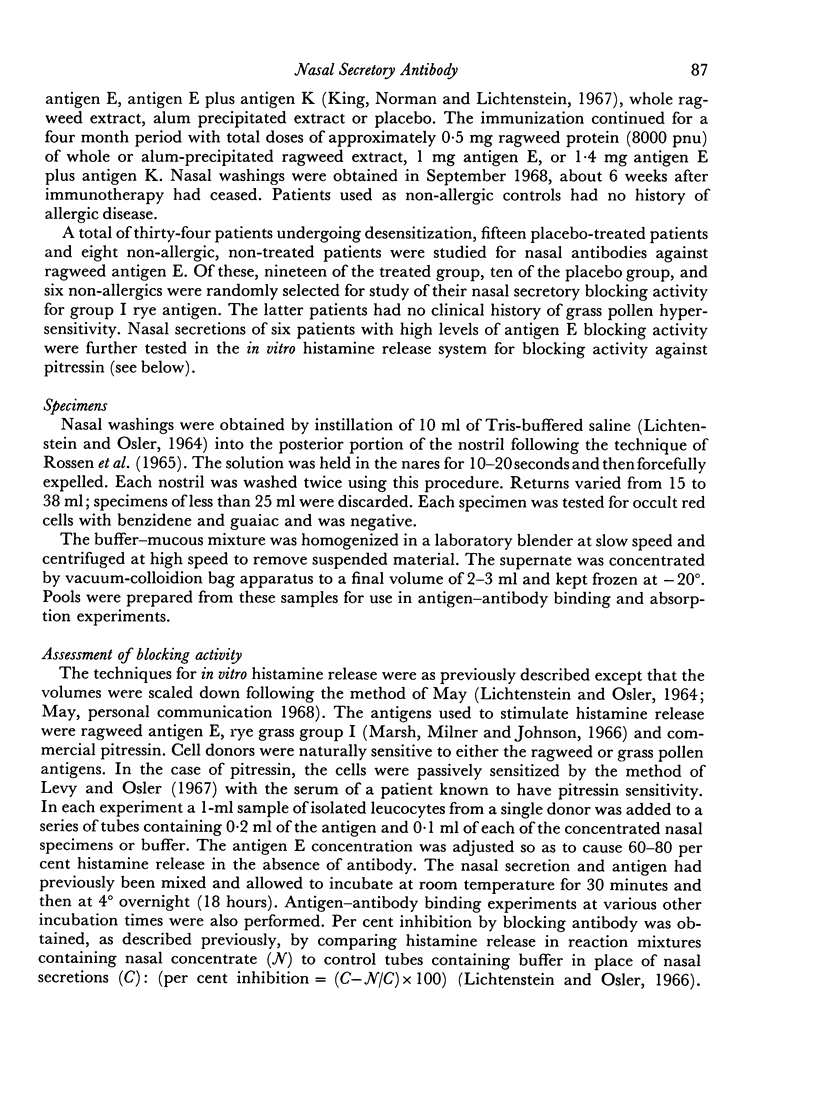
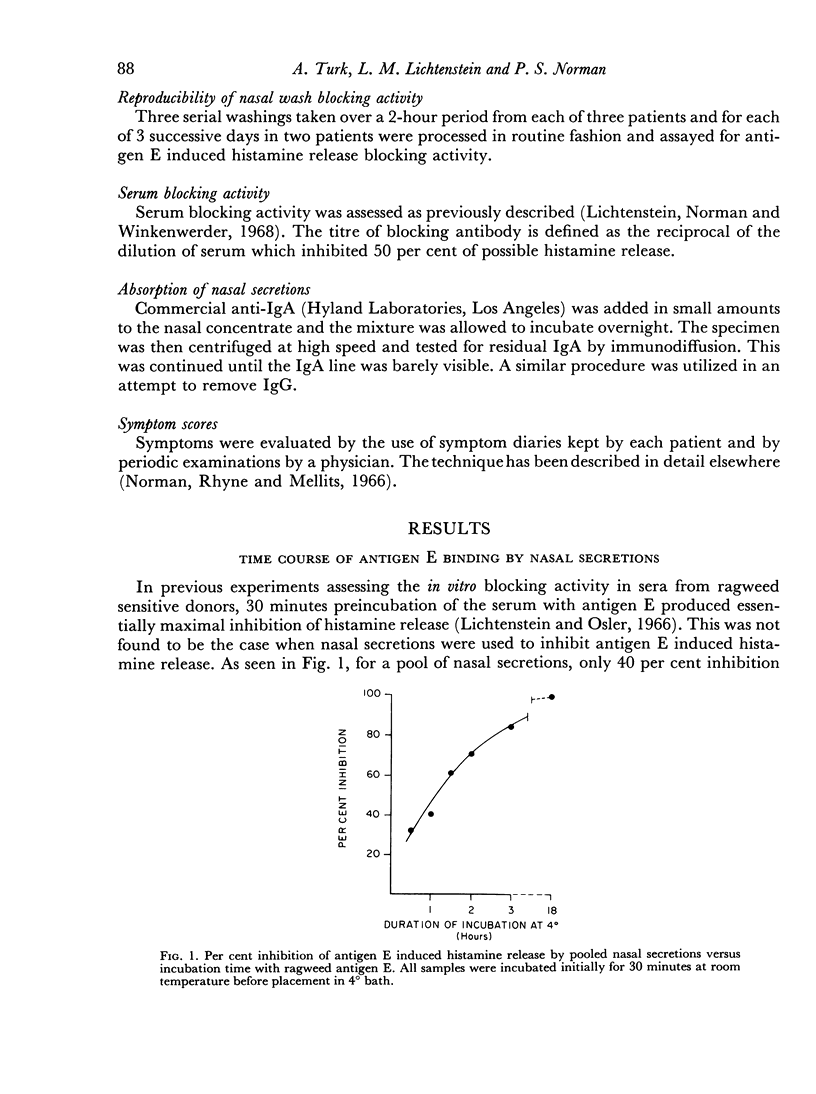


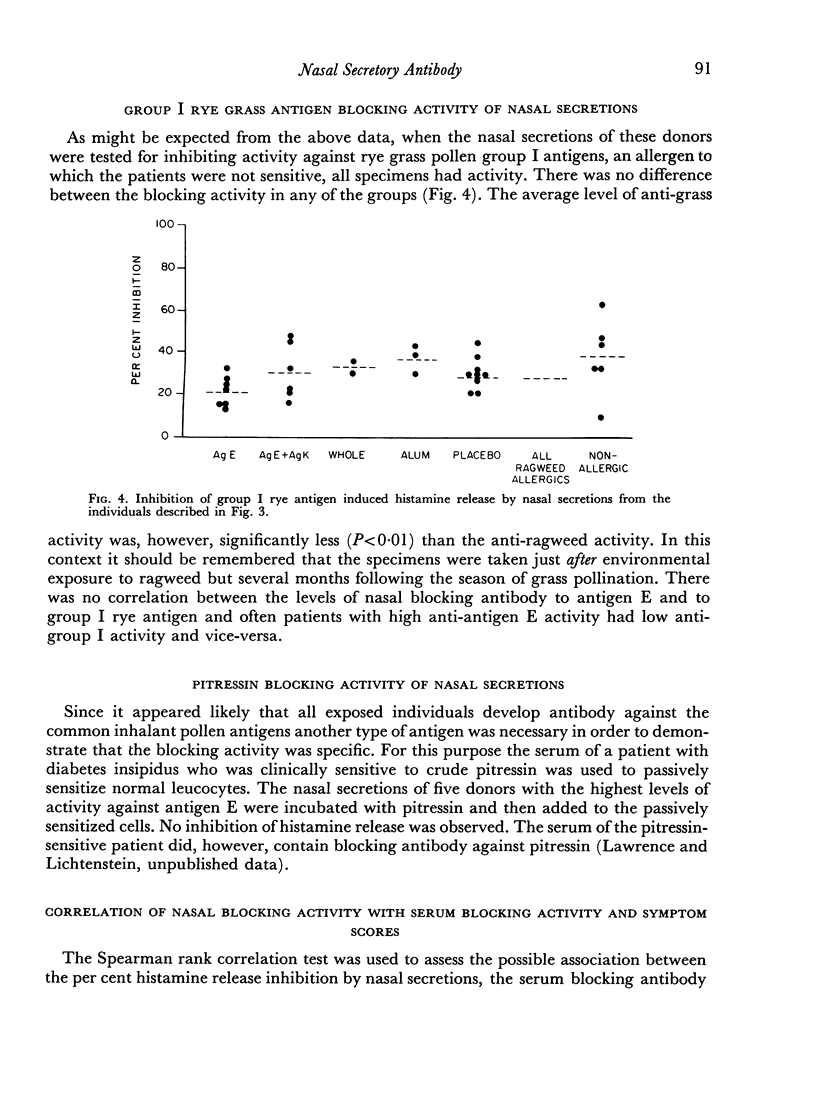
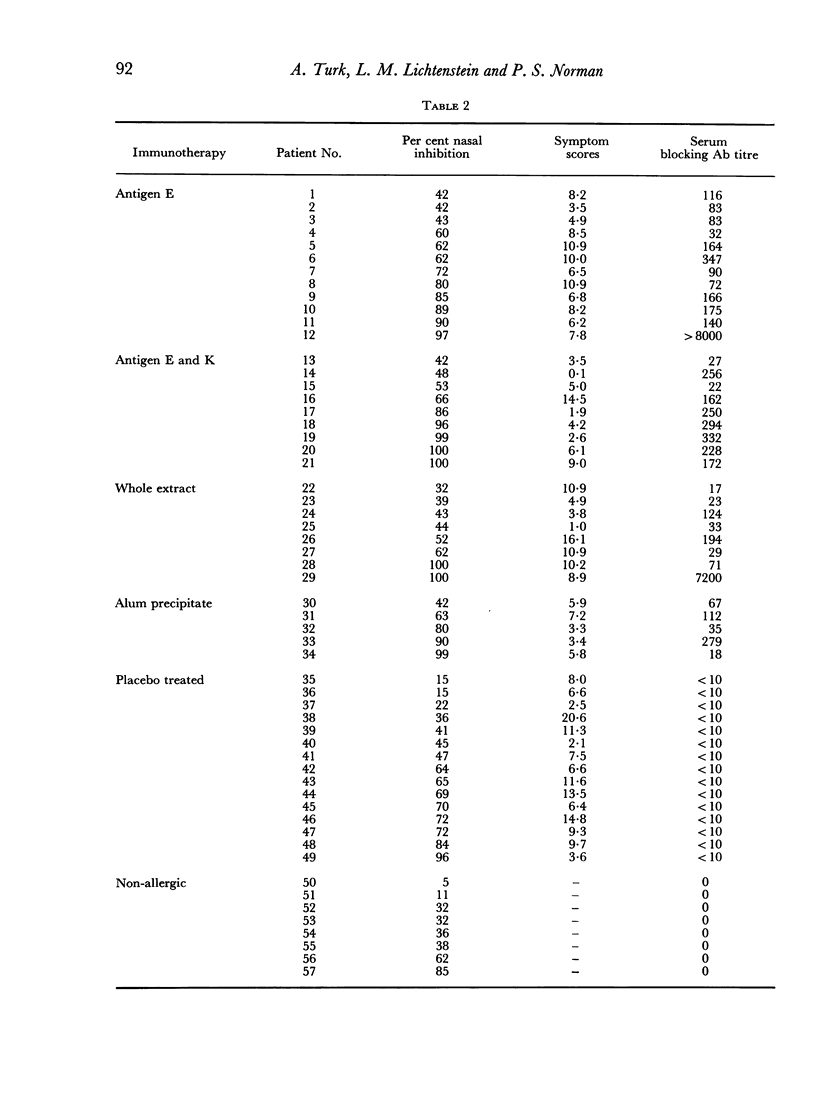
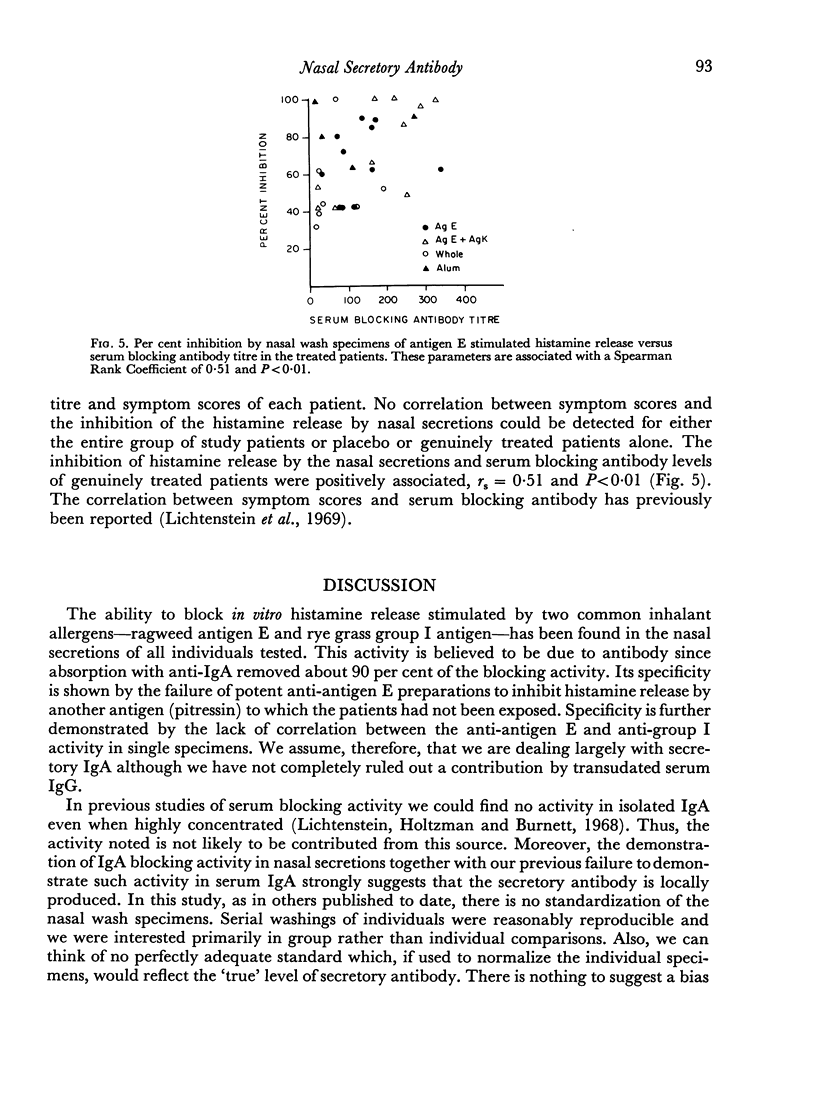
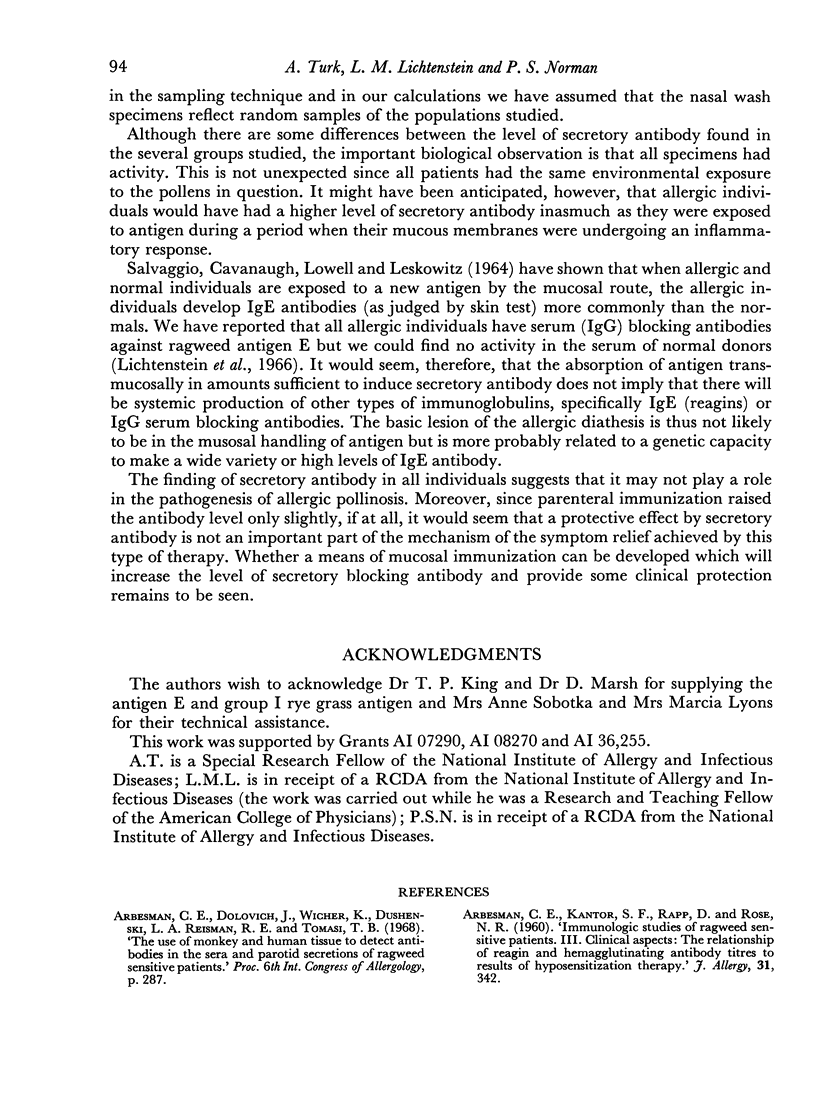

Selected References
These references are in PubMed. This may not be the complete list of references from this article.
- ARBESMAN C. E., KANTOR S. Z., RAPP D., ROSE N. R. Immunologic studies of ragweed-sensitive patients. III. Clinical aspects: the relationship of reagin and hemagglutinating antibody titers to results of hyposensitization therapy. J Allergy. 1960 Jul-Aug;31:342–350. doi: 10.1016/0021-8707(60)90070-8. [DOI] [PubMed] [Google Scholar]
- ARTENSTEIN M. S., BELLANTI J. A., BUESCHER E. L. IDENTIFICATION OF THE ANTIVIRAL SUBSTANCES IN NASAL SECRETIONS. Proc Soc Exp Biol Med. 1964 Nov;117:558–564. doi: 10.3181/00379727-117-29637. [DOI] [PubMed] [Google Scholar]
- Douglas R. G., Jr, Rossen R. D., Butler W. T., Couch R. B. Rhinovirus neutralizing antibody in tears, parotid saliva, nasal secretions and serum. J Immunol. 1967 Aug;99(2):297–303. [PubMed] [Google Scholar]
- ISHIZAKA K., DENNIS E. G., HORNBROOK M. PRESENCE OF REAGIN AND GAMMA-GLOBULIN IN SALIVA. J Allergy. 1964 Mar-Apr;35:143–148. doi: 10.1016/0021-8707(64)90028-0. [DOI] [PubMed] [Google Scholar]
- KING T. P., NORMAN P. S., CONNELL J. T. ISOLATION AND CHARACTERIZATION OF ALLERGENS FROM RAGWEED POLLEN. II. Biochemistry. 1964 Mar;3:458–468. doi: 10.1021/bi00891a026. [DOI] [PubMed] [Google Scholar]
- King T. P., Norman P. S., Lichtenstein L. M. Isolation and characterization of allergens from ragweed pollen. IV. Biochemistry. 1967 Jul;6(7):1992–2000. doi: 10.1021/bi00859a017. [DOI] [PubMed] [Google Scholar]
- LICHTENSTEIN L. M., OSLER A. G. STUDIES ON THE MECHANISMS OF HYPERSENSITIVITY PHENOMENA. IX. HISTAMINE RELEASE FROM HUMAN LEUKOCYTES BY RAGWEED POLLEN ANTIGEN. J Exp Med. 1964 Oct 1;120:507–530. doi: 10.1084/jem.120.4.507. [DOI] [PMC free article] [PubMed] [Google Scholar]
- Levy D. A., Osler A. G. Studies on the mechanisms of hypersensitivity phenomena. XV. Enhancement of passive sensitization of human leukocytes by heparin. J Immunol. 1967 Dec;99(6):1062–1067. [PubMed] [Google Scholar]
- Lichtenstein L. M., Holtzman N. A., Burnett L. S. A quantitative in vitro study of the chromatographic distribution and immunoglobulin characteristics of human blocking antibody. J Immunol. 1968 Aug;101(2):317–324. [PubMed] [Google Scholar]
- Lichtenstein L. M., Norman P. S., Winkenwerder W. L. Clinical and in vitro studies on the role of immunotherapy in ragweed hay fever. Am J Med. 1968 Apr;44(4):514–524. doi: 10.1016/0002-9343(68)90052-1. [DOI] [PubMed] [Google Scholar]
- Lichtenstein L. M., Norman P. S., Winkenwerder W. L., Osler A. G. In vitro studies of human ragweed allergy: changes in cellular and humoral activity associated with specific desensitization. J Clin Invest. 1966 Jul;45(7):1126–1136. doi: 10.1172/JCI105419. [DOI] [PMC free article] [PubMed] [Google Scholar]
- Lichtenstein L. M., Osler A. G. Studies on the mechanisms of hypersensitivity phenomena. XII. An in vitro study of the reaction between ragweed pollen antigen, allergic human serum and ragweed-sensitive human leukocytes. J Immunol. 1966 Jan;96(1):169–179. [PubMed] [Google Scholar]
- Lowell F. C., Franklin W. A double-blind study of the effectiveness and specificity of injecton therapy in ragweed hay fever. N Engl J Med. 1965 Sep 23;273(13):675–679. doi: 10.1056/NEJM196509232731302. [DOI] [PubMed] [Google Scholar]
- Marsh D. G., Milner F. H., Johnson P. The allergenic activity and stability of purified allergens from the pollen of common rye grass (lolium perenne). Int Arch Allergy Appl Immunol. 1966;29(6):521–535. doi: 10.1159/000229739. [DOI] [PubMed] [Google Scholar]
- Rossen R. D., Butler W. T., Cate T. R., Szwed C. F., Couch R. B. Protein composition of nasal secretion during respiratory virus infection. Proc Soc Exp Biol Med. 1965 Aug-Sep;119(4):1169–1176. doi: 10.3181/00379727-119-30406. [DOI] [PubMed] [Google Scholar]
- SALVAGGIO J. E., CAVANAUGH J. J., LOWELL F. C. A COMPARISON OF THE IMMUNOLOGIC RESPONSES OF NORMAL AND ATOPIC INDIVIDUALS TO INTRANASALLY ADMINISTERED ANTIGEN. J Allergy. 1964 Jan-Feb;35:62–69. doi: 10.1016/0021-8707(64)90050-4. [DOI] [PubMed] [Google Scholar]
- SETTIPANE G. A., CONNELL J. T., SHERMAN W. B. REAGIN IN TEARS. J Allergy. 1965 Jan-Feb;36:92–96. doi: 10.1016/0021-8707(65)90036-5. [DOI] [PubMed] [Google Scholar]
- Sadan N., Rhyne M. B., Mellits E. D., Goldstein E. O., Levy D. A., Lichtenstein L. M. Immunotherapy of pollinosis in children: investigation of the immunologic basis of clinical improvement. N Engl J Med. 1969 Mar 20;280(12):623–627. doi: 10.1056/NEJM196903202801201. [DOI] [PubMed] [Google Scholar]
- Smith C. B., Bellanti J. A., Chanock R. M. Immunoglobulins in serum and nasal secretions following infection with type 1 parainfluenza virus and injection of inactivated vaccines. J Immunol. 1967 Jul;99(1):133–141. [PubMed] [Google Scholar]
- Waldman R. H., Mann J. J., Kasel J. A. Influenza virus neutralizing antibody in human respiratory secretions. J Immunol. 1968 Jan;100(1):80–85. [PubMed] [Google Scholar]


